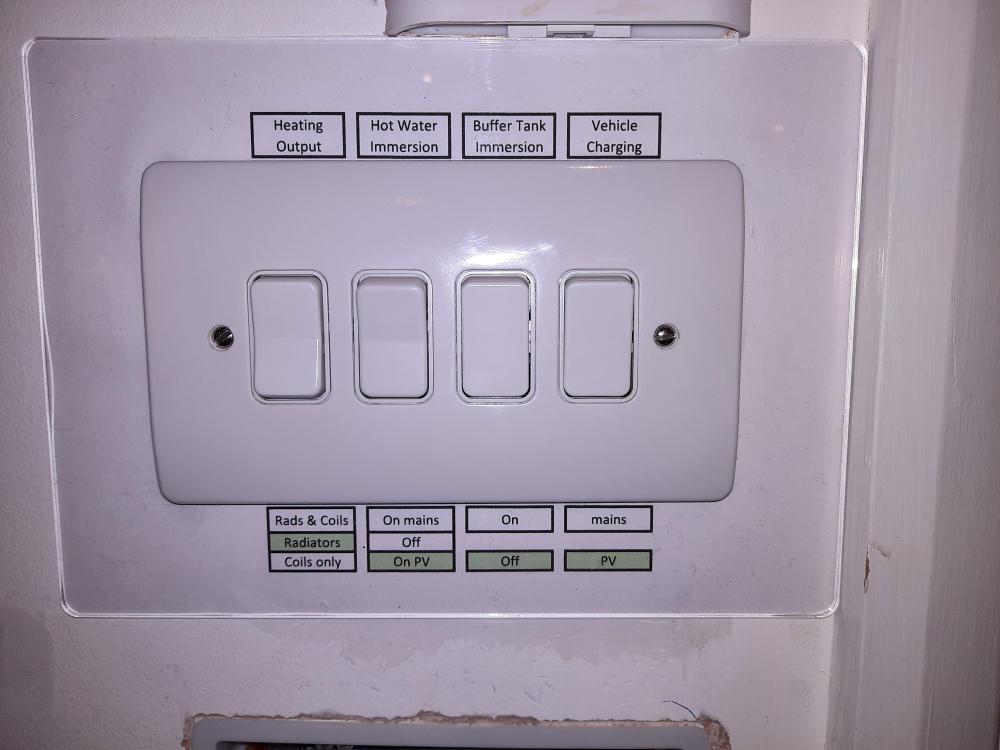Fitting and running an ASHP
Since January 5th we have used 222kWh on the ASHP over the last 26 days. That's about 9kWh per day for heating and hot water.
However some days the hot water temperature has been boosted by the PV excess power going into the immersion heater so let's assume 8kWh per day for 100m2 home. The heating is running 24 hours a day at an average of 20C. The outside temperature has been low (I will look up the records later) with only about 4 nights of frost.
Results from trying different programmes seems to indicate that running the heating all night at about 2C lower than day temperature uses less energy than turning it off over night and letting the building drop lower and then reheating in the morning.
Some mornings at 6am it is a lot colder than between 10pm and 4am and I think the ASHP has to work alot harder in a colder temperature a lot longer to enable the house to reach the required temperature.
Interestingly, when we were out all day the system used even less power to maintain temperature even though we left it running.
Another item that effects these results seems to be the amount of power used in the building almost regardless of the purpose of its use. I will start keeping a record of the whole house energy use to observe the results.
Another is solar gain. Others are leaving doors open for extended periods of time, and body heat from things like housework.
When we were leaving the heating off in the night I noticed that the north east bedroom became colder than the rest of the house. Having installed the insulation and vapour barrier myself I reason that this is due to wind chill as this is the most exposed part of the building.
The ASHP Ambient Temperature probe registered 15.6C two mornings ago at about 9.30 in the morning although it was actually only about 6C. This caused the ASHP to lower its output temperature and the house was a degree or two lower. So I have shielded the probe against direct sunlight and this seems to be working..
The weather compensation mode in the ASHP control system relates the outside air temperature to the ASHP output, in an attempt to produce the minimum heat required to satisfy the temperature required in the building. Set up correctly this will lower the temperature of the ASHP output in line with a rising outside temperature and vice versa.
In my opinion, the setting of the weather compensating levels would need to be adjusted for each individual property in order to have any chance of success.
Because this bungalow can over heat when the outside temperature is above 10C I have adjusted the water temperatures down in the weather compensation control area.
We have not tried out the cold settings yet as the weather has been mild.
The coils in the mechanical ventilation heat recovery (MVHR) ducting work well in heating mode. The air from outside , at about 5C, goes through the heat exchanger ( raising the temp to about 19C, then along one of the main supply ducts and through the heated water coil (water circulated from the buffer tank), before splitting up into outlet ducts and entering the rooms at about 26C.
The cooling opperation will have to wait until the summer to be tested.
Having installed additional insulation around both the hot water tank and the Buffer tank the loss of heat greatly improved. The utility room is now at about 21C unless washing is going on.
I am very glad we managed to keep all the tanks etc inside the building's thermal envelope and all the 28mm pipes with maximum pipe insulation.
It may be this is long and boring but hopefully someone will read this before installing an ASHP and benefit from my experience.
Good luck.
M
The best combination:
-
 2
2



4 Comments
Recommended Comments
Create an account or sign in to comment
You need to be a member in order to leave a comment
Create an account
Sign up for a new account in our community. It's easy!
Register a new accountSign in
Already have an account? Sign in here.
Sign In Now